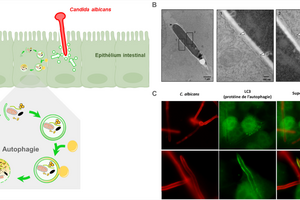Pierre Lapaquette*, Amandine Ducreux*, Louise Basmaciyan, Tracy Paradis,
Fabienne Bon, Amandine Bataille, Pascale Winckler, Bernhard Hube, Christophe
d'Enfert, Audrey Esclatine, Elisabeth Dubus, Marie-Agnès Bringer, Etienne Morel
and Frédéric Dalle.
This research article published in January in the journal "Gut microbes" highlights an original protective role for proteins belonging to the autophagy machinery in the defence of our cells against infection by opportunistic yeast pathogens Candida albicans (C. albicans).
This yeast belongs to the normal intestinal microbiota (IM) of healthy humans. In certain situations where the host's digestive homeostasis is disrupted (e.g. immune deficiency, digestive tissue inflammation, etc., but also dysbiosis of the gut microbiota), C. albicanscan be responsible for opportunistic infections in humans, ranging from superficial to disseminated forms throughout the body, which are potentially fatal. The origin of these disseminated forms is mainly digestive where, in certain pathological situations, C. albicans can cross the intestinal barrier and disseminate in the bloodstream, even invading other organs secondarily. Crossing the intestinal barrier involves the ability of C. albicans to invade intestinal epithelial cells during its development in the form of filaments (hyphae). In this study, we were able to show, in vitro and in vivo, that when C. albicans invades intestinal epithelial cells, it causes damage to the host cell's plasma membrane.This damage is detected by the infected cell, which triggers intense recruitment of proteins from the autophagy machinery to the invasion site (see illustration below). The cellular process of autophagy corresponds to the formation of membrane vacuoles that play a protective role in our cells, notably by enabling the degradation of dangerous elements (bacteria, viruses, altered mitochondria) that are sources of stress for the cells. In an original way, in the case of C. albicans, the activation of this autophagy machinery in intestinal epithelial cells enables the damage to the plasma membrane induced by the invasion of C. albicans to be repaired by promoting a supply of membrane. Our results suggest that the autophagy machinery enables the cell to form membrane dressings of sorts to counteract the damage induced by infection. This work paves the way for a better understanding of the roles played by molecules associated with the autophagy process in membrane dynamics and defence against microbial infection..
The article is available in free access at the following link : https://www.tandfonline.com/doi/full/10.1080/19490976.2021.2004798 .
Protective autophagy response during infection of epithelial cells by Candida albicans :
- (A) Candida albicans filament (red) actively penetrates the intestinal epithelial cell. In response to this stress, the infected cell activates the process of autophagy (details in the grey box). This process involves portions of the membrane inside the cell elongating to form an isolation membrane that traps the elements to be degraded. Closure of this isolation membrane leads to the formation of a vacuole, called an autophagosome, which may eventually fuse with the lysosomes and lead to the degradation of the trapped elements. Activation of autophagy during C. albicans penetration mobilises membranes (green circles) at the invasion site and limits the membrane damage caused by the fungal infection.
- (B) Electron microscopy images showing the penetration of an epithelial cell (light grey) by a C. albicans filament (dark grey). The white arrows indicate lesions on the host cell's plasma membrane.
- (C) Fluorescence microscopy images showing intense recruitment of the autophagy protein LC3 (green) to the C. albicans invasion site (red) in human epithelial cells.







